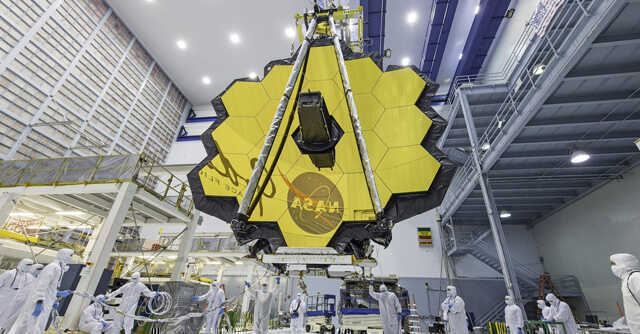
James Webb Space Telescope: What is it, how it differs from Hubble and why is it a big deal?


The James Webb Space Telescope (JWST) is no longer stuck on Earth. In a globally followed event that was rejoiced by scientists, engineers and observers alike, JWST is on its way to its eventual sitting point -- from where it will peer out into the ancient space. The most powerful space telescope ever made, JWST is expected to give mankind a glimpse into the universe’s earliest stars, which were formed soon after the Big Bang.
In essence, it is slated to contribute to one of the biggest questions that science has asked -- how did the universe evolve and why did we get here?
On this note, here’s looking at how the James Webb telescope differs from Hubble Space Telescope (HST), the fundamental technology that powers it and why it is such a big deal.

Also read: Hubble control unit to receive software fix as NASA seeks to reactivate iconic telescope
The key tech
The piece de resistance of the James Webb Space Telescope is its primary mirror -- the largest one ever built for a telescope. The main optical element combines 18 gold-plated beryllium hexagonal mirror segments to create a 6.5 metres-wide primary mirror. This will work at a super-frigid temperature of -223 degrees Celsius (50K) to capture redshifted infrared spectra coming in from the farthest corners of the universe.

The primary mirror is in fact so large that it had to be converted into collapsible elements -- for a launch vehicle to carry it into space. The primary mirror will use a technique called image plane waveform sensing to position the 18 mirror elements in the correct position. To do the latter, the telescope has micro-motors on them.
This breakthrough technology, scientists have said, will mean that the JWST only needs focal calibration once every few days -- in comparison to many ground telescopes that do active mirror recalibration.
The telescope also has curved secondary and tertiary mirrors that reduce optical aberrations (i.e. irregularities or faults in the images) over wide focal fields. There is also a ‘fine steering mirror’, which adds to the image stabilisation -- all of which gives the JWST a drastic resolution improvement over previous, flagship space telescopes such as Hubble itself.

The JWST comes with a massive, collapsible sun shield, which will help it maintain this temperature of operation. To do this, the engineers of JWST used Kapton type-E -- a polyimide film material first pioneered by American chemical corporation, DuPont, and coated it with silicon and aluminium.
Finally, the integrated science instrument module (ISIM) of the JWST carries with itself a guide camera for navigation, along with four key instruments -- a near-infrared camera (NIRCam) built by Lockheed Martin for wavefront sensing tasks (described above); a near-infrared spectrograph (NIRSpec) built by the European Space Agency, Airbus Defence and Space, Carl Zeiss Optronics and others -- for space observation; a mid-infrared instrument (MIRI) camera and spectrometer built by NASA, Carl Zeiss and others -- for observation; and finally, the fine guidance sensor (FGS) and near-infrared imager and slitless spectrograph (NIRISS). The latter is meant for observation as well as stabilisation of the telescope’s line of sight.
How different is it from Hubble?

Fundamentally, the JWST is an infrared space telescope. It operates on the principle of cosmological redshift based on Hubble’s Law.
The latter states that galaxies in the universe are moving away from the Earth as the universe expands and the speed of them moving away from the Earth is directly proportional to their distance from our planet.
In simpler words, the farther the galaxy, the faster it is moving away from us. This makes light emitted by these galaxies change in property, where their wavelengths increase and the energy of their particles decrease. This ‘shifts’ the light coming in from the universe’s oldest galaxies, which are constantly moving away from us, towards the red end of the electromagnetic spectrum -- and is therefore known as a redshift.

It is this that is the James Webb Telescope’s superpower over Hubble. The latter looks at the optical and ultraviolet (UV) wavelengths of electromagnetic radiation in space, and its observations urged scientists to explore longer wavelengths in observing more areas of space -- in our quest to understand the oldest, earliest years of the universe.
Hubble also has a significantly smaller primary mirror -- which at 2.4 metres was itself one of the largest ever created.
Why is it a big deal?

The JWST is potentially pathbreaking as it will pave the way for observations so far not possible -- a chance to take a look at the early universe. It gives us a way to see the conditions that were prevalent in the universe just after the singularity event, the Big Bang.
Scientists have often held steadfast that understanding the earliest years of formation of the universe will be key to understanding how we have evolved -- and may hold key answers in our hunt for extraterrestrial life.
Observations made through the JWST could potentially point out identifiers of conditions, reactions and trajectories that led to the formation of our solar system, our planet, and eventually, the evolution of life on earth. Using this information, the long-term goal for the astrophysics community is to match the identifiers with observations of equally ancient solar systems in distant galaxies -- to understand how life could have flourished elsewhere, too.
